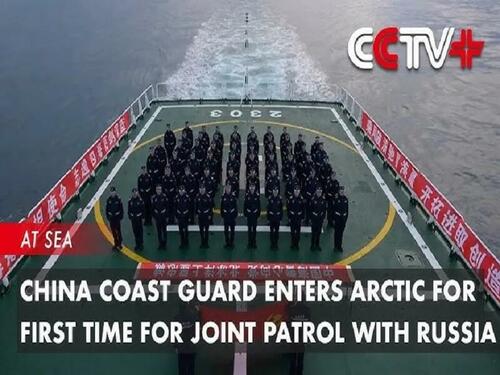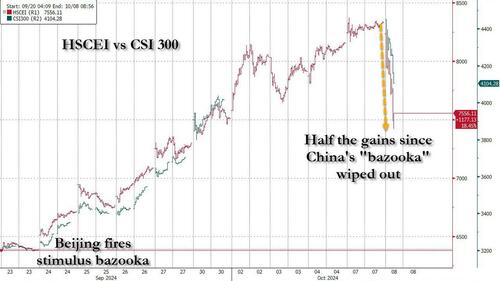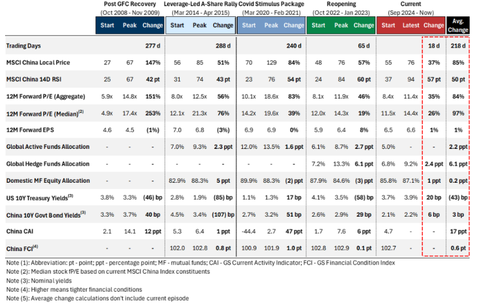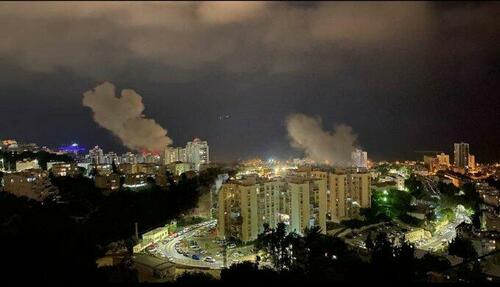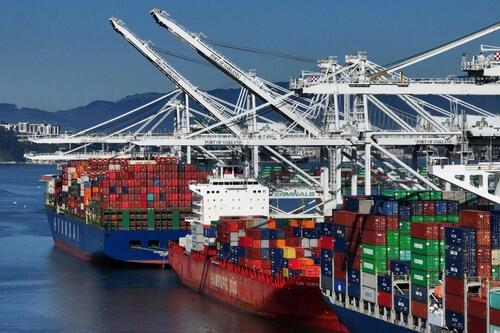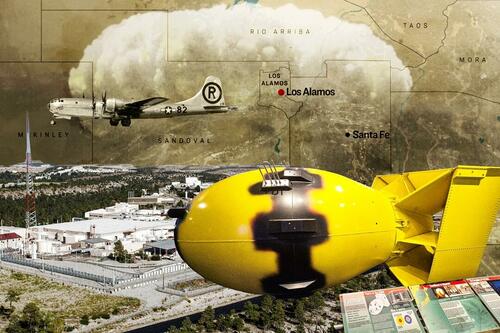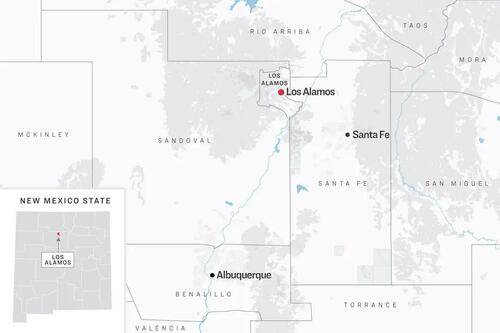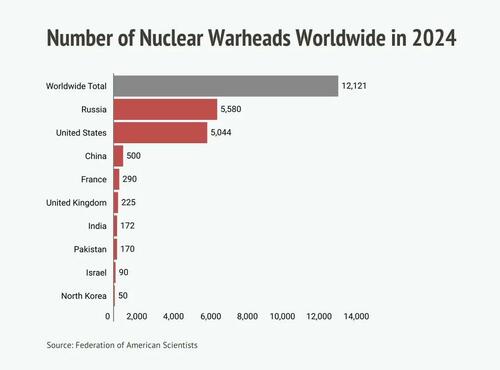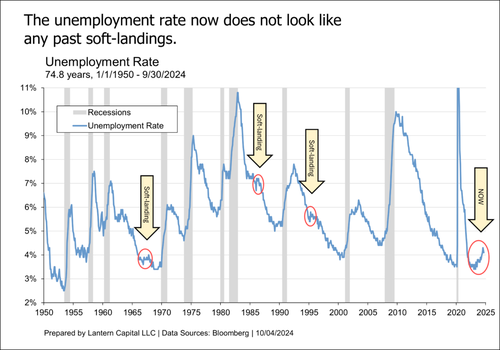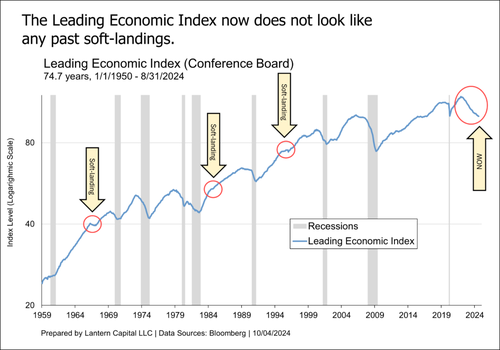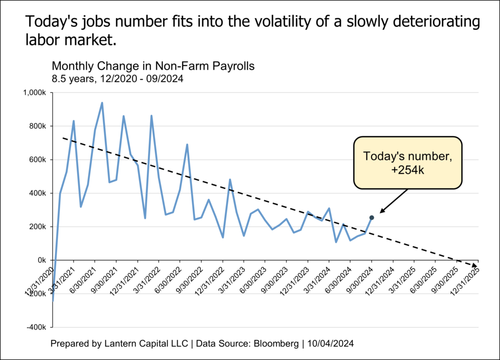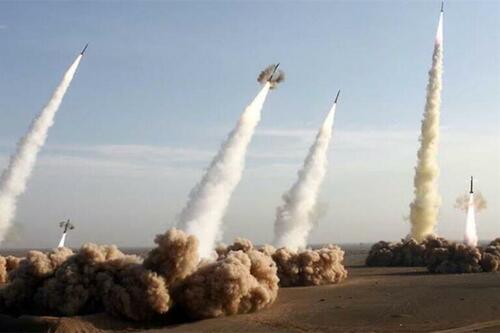Russia Tacitly Recognizes China’s Self-Proclaimed Status As A “Near-Arctic State”
Russia Tacitly Recognizes China’s Self-Proclaimed Status As A “Near-Arctic State”
Authored by Andrew Korybko via Substack,
CNN reported last week that “China’s Coast Guard claims to have entered the Arctic Ocean for the first time as it ramps up security ties with Russia”, though at the time of writing, neither the Russian nor American Coast Guards confirmed their presence in the Arctic. CNN also noted that TASS’ report on this only cited the China Coast Guard’s (CCG) statement on its WeChat page. It’s therefore dubious whether the CCG actually entered the Arctic or just remained in the Bering Sea.
This distinction is important since the perception that Sino-Russo Coast Guard drills were just carried out in the Arctic, no matter how possibly inaccurate as clarified by CNN to its credit, could fuel the West’s efforts to contain Russia along that front. It also adds false credence to the artificially manufactured speculation that Russia is willing to cede sovereignty rights there to China after becoming disproportionately dependent on it over the past two years since the special operation began.
About that, readers should be aware of several relevant pieces of Russian legislation for governing its Arctic maritime territory. A 2017 law banned shipping oil, natural gas, and coal along the Northern Sea Route (NSR) under a foreign flag, while a 2018 one mandates that these ships will also have to be built in Russia. These were complemented by a 2022 law stipulating that all foreign warships must require prior permission to transit the NSR, and only one can do so at a time. These three laws remain on the books.
Their purpose is to ensure that Russia profits as much as is realistically possible from the NSR and can properly protect its sovereignty there. China poses no threat to Russian sovereignty, but allowing its warships to operate unrestricted within Russia’s territorial waters could raise the chances of an incident at sea with its Western Arctic rivals, especially the US. There’s also no reason for them to be there anyhow since Russia is more than capable of ensuring security along this route on its own.
The same can be said for the CCG seeing as how the Arctic is obviously far away from the Chinese coast, but it’s possible in theory that those of its icebreakers that already entered these waters for the first time over the summer could be escorted by the CCG as they lead the way for commercial vessels. If that happens, then this would likely be coordinated with Russia as part of a signal to the West as intuited by what head of the new Maritime Board Nikolai Patrushev hinted at in an interview over the summer.
This could possibly be preceded by formal naval drills in the Arctic Ocean, once again for the same purpose of sending a signal to the West, albeit a misleading one since China isn’t an Arctic naval power and it also has no mutual defense commitments to Russia like such a stunt might make some think. Those aforementioned false perceptions would be deliberately fanned in these scenarios for sending a signal to the West despite the likelihood that it would be exploited to fuel containment along this front.
Russia might conclude that there’s nothing that it can do to stop these developments anyhow so it’s therefore better to play along with these perceptions in order to boost its soft power across the Global South by making these countries think that it and China are jointly countering the West in the Arctic. Even in that case, however, Russia will remain the senior partner in this aspect of its relationship since it’s an actual Arctic state while China claims to only be a so-called “near-Arctic” one.
China’s policy is meant to ensure it a seat at the table in multilateral discussions about that body of water through which it plans to expand trade with Europe via the NSR. This is the natural evolution of its desire to play a greater role in global governance in general and specifically in all emerging frontiers like the Arctic, AI, climate change, etc. The CCG’s drills with their Russian counterparts there, even if they were only in the Bering Sea, reinforces its claim as a “near-Arctic state” due to its adjacency to the Arctic.
Russia tacitly supports this claim as proven by the above, but it remains unclear whether it’s comfortable with China playing a role in Arctic governance, which Russia is reluctant to internationalize since it fears that this could lead to more pressure to curtail the sovereignty rights that it enshrined into law there. All countries want to cut costs on trade so there’s no reason why China wouldn’t want its own natural gas, oil, and coal ships to sail along the NSR instead of having to contract Russia’s for this task.
To avoid any misunderstanding, nothing is being implied about an impending problem in their strategic partnership over this issue since all that’s being put forth is that they have natural differences over this issue, though they’ve thus far been responsibly managed and there’s no reason to expect this to change. Sino-Russo cooperation in the Arctic is indisputably on pace to continue, including in the security dimension, though energy and logistical cooperation are expected to remain the drivers of this trend.
Tyler Durden
Tue, 10/08/2024 – 23:25
No Interventionist Government Or Central Bank Wants Lower Prices
No Interventionist Government Or Central Bank Wants Lower Prices
Many citizens want more government control of the economy to curb rising prices. It is the worst strategy imaginable. Interventionist governments never reduce consumer prices because they benefit from inflation, dissolving their political spending commitments in a constantly depreciated currency. Inflation is the perfect hidden tax. The government makes the currency less valuable by issuing more units of fiat money, partially dissolves its debt in real terms, collects more taxes, and presents itself as the solution to rising prices with subsidies in an increasingly worthless currency. That is why socialism and hyperinflation go hand in hand.
Socialism rejects human action and economic calculation and sells a false image of a government that can create wealth at will by issuing more units of fiat currency. Obviously, when inflation arrives, the socialist government will use its two favorite tools: propaganda and repression. Propaganda, which accuses stores and businesses of driving up prices, and repression, which occurs when social unrest intensifies and citizens legitimately hold governments accountable for scarcity and high prices, are the two main strategies.
If you want lower prices, you need to give less economic power to the government, not more. Only free markets, competition, and open economies help decrease consumer prices. Many readers might think that we currently have a free market with competitive and open economies, but the reality is that we live in increasingly intervened and overregulated nations where central banks and governments work to perpetuate unsustainable public deficits and debt. Therefore, they continue to print more money, leading many to question why it is getting harder for families to make ends meet, buy a home, or for small businesses to prosper. The government is slowly eating away the currency it issues. They call it “social use of money.”
What is “social use of money”? In essence, it means abandoning one of the main characteristics of money, the reserve of value, to give the government preferential access to credit to finance its commitments. Therefore, the state can announce larger entitlement programs and increase the size of the public sector relative to the economy, creating a self-fulfilling prophecy. The state issues more currency, which makes people’s money less valuable. Citizens become more dependent on the state, and they will demand more subsidies paid in the currency the state issues. It is, in essence, a process of control through debt and currency depreciation.
When governments and central banks talk about price stability, it means a two percent annual depreciation of the currency. Aggregate prices rising an average of two percent is hardly price stability because it is measured by the consumer price index, which is a carefully crafted basket of goods and services weighted by the same people who print the money. That is why governments love CPI as a measure of inflation. It fails to fully reflect the erosion of the currency’s purchasing power. This is why the CPI’s basket calculation fluctuates so frequently. Even if it accurately measures, it will underestimate the rise in prices of non-replaceable goods and services by adding them to a basket of things we consume maybe once or twice a year at best. When you put together shelter, food, health, and energy with technology and entertainment, there will always be distortions.
Thus, governments and central banks are never going to defend price stability. If aggregate prices fell, competition soared, and citizens saw their real wages rise and their deposit savings increase in real value, their jobs would disappear.
When a central bank like the Fed cuts rates and increases the money supply after an accumulated 20.4% inflation in four years, it is not defending price stability; it is defending price increases. This strategy serves to conceal the government’s financial insolvency. A currency with a declining value.
Governments are the ones that create inflation by spending a currency that is constantly losing purchasing power because the state issues more than what the private sector demands. No corporation or allegedly evil oil producer can make aggregate prices rise and continue increasing annually at a lower pace. Only the one that prints the money, and central banks don’t print money because they want to; they increase the money supply to absorb rising public deficit spending.
Inflation is a hidden tax, a slow process of nationalization of the economy, and the perfect way to increase taxes without angering voters and blaming private businesses in the meantime. The consumer will likely blame the store or business for higher prices, not the issuer of a currency that loses purchasing power.
Why would governments want higher prices? Because it gives them more power. Destroying the currency they issue is a perfect form of control. That is why they need more debt and higher taxes. High taxes are not a tool to reduce debt, but rather to justify rising public indebtedness.
You may have read numerous times that the government has unlimited borrowing power and can manage inflation to allow you to live comfortably. It is false. The government cannot issue all the debt it wants. It has an inflationary, economic, and fiscal limit.
Inflation is a warning sign of declining currency confidence and a loss of purchasing power. The economic limit is evidenced by lower growth, lower employment, weaker real wages, secular stagnation, and declining foreign demand for public debt.
The fiscal limit is evidenced by soaring interest expenses even with low rates, weaker receipts every time they hike taxes, and citizens and businesses leaving the country to more friendly tax systems, all of which add to the poor or negative multiplier effect of government spending.
If you want lower prices, you should give less economic power to governments, not more.
A government that tells you it will borrow $2 trillion per annum in a growth and record receipt economy and will continue to increase debt and borrow well into 2033 with the most optimistic assumptions of GDP and receipt is telling you it will make you poorer.
When a politician promises that he or she will cut prices, they are always lying. A weaker currency is a tool to increase government power in the economy. By the time you find out, it may be too late.
Money is credit, and government debt is fiat currency. Currency depreciation is inflation, and inflation is equivalent to an implicit default. No interventionist government or central bank wants lower prices because inflation allows the government to increase its power while slowly breaching its monetary commitments.
Tyler Durden
Tue, 10/08/2024 – 07:20
Hong Kong Crashes As China’s Stimulus Frenzy Ends With A Bang
Hong Kong Crashes As China’s Stimulus Frenzy Ends With A Bang
There is some good news and some bad news for China bulls this morning (local time).
First the good news: since mainland China (aka A-shares) were closed for the past week, mainland Indexes such as the Shanghai Shenzhen CSI 300 are up – just barely – because after opening up almost 11% to catch up with the frenzied rally in offshore markets and ETFs, the index has erased almost all gains since it closed for trading on Sept 30.
For the real action, one has to go to neighboring Hong Kong, which was open while China was closed, and which proceeded to soar as much as 30% since the China stimulus bazooka was fired on Sept 23 (just two days after we said it would be). It’s also were the bad news is because one look at what the local Hang Seng China Enterprises Index is doing, and HK longs will want to throw up: as shown below, not only are HK stocks down as much as 11% after the open, but they have somehow managed to wipe out almost half the gains since the bazooka was launched in less than two hours!
What sparked this liquidation? Well, yesterday China unveiled yet another “emergency” stimulus meeting, this time held by the National Development and Reform Commission (i.e., China’s central planning bureau). Expectations were high that just like the emergency Sept 26 Politburo meeting which was led by president Xi himself, today China would unveil even more sweet, sweet stimmies.
Alas it was not meant to be, and the press conference led by Zheng Shanjie, chairman of China’s top economic planner, the National Development and Reform Commission was an epic dud: in it, Shanjie said that while external risks and downward economic pressures were increasing, they remained confident of achieving the full-year GDP growth target. He said new policy measures will focus on expanding domestic demand, increasing support and the property and capital markets.
In short, nothing new, and certainly nothing even remotely close to the Rmb 10 trillion in fiscal stimmies that many were expecting. As UBS writes, “the NDRC press conference has released no details on fiscal stimulus so far, with the Q&A session ongoing. Zheng Shanjie along with deputy heads Liu Sushe, Zhao Chenxin, Li Chunlin and Zheng Bei, were widely expected to announce an action plan at the press conference. As a result, USDCNH is coming up, while iron ore and copper are declining. Shenzhen’s ChiNext has narrowed gains to 13% from more than 18% earlier as China returned from the Golden Week holiday.“
What is the take home message here? First, that Jim Cramer was – as usual – a fade.
Cramer: “You have to come in China stocks right now”
That’s the top.
— zerohedge (@zerohedge) October 2, 2024
The second, and far more important message, is that the half life of Beijing’s latest attempt to goose markets, at just around 10 days is the shortest of all…
… and it means that with the market having called Beijing’s bluff, Xi has two options:
- Do another half-assed attempt to stimulate the economy with the very limited measures already unveiled, which he knows – and more importantly the market knows – will achieve nothing, and spark another market crash and economic meltdown, or
- Do what Goldman trader Borislav Vladimirov laid out yesterday, when he said that China Must Do QE Now, “Or It Will End Up In A Bigger Hole In 12 Months.”
And since for Xi the time for half-measures is now over, especially if he wants to avoid a deflationary spiral, social insurrection and political mutiny, this only leaves one option open: the truly nuclear one. The only question is when, because while the market may have peaked at +30% the first time China tried to goose markets, the next time we are talking triple digits, not to mention $3K gold and $100K+ bitcoin.
Tyler Durden
Mon, 10/07/2024 – 23:28
Watch: Hezbollah Unleashes Massive Missile Strikes On Israel’s Haifa
Watch: Hezbollah Unleashes Massive Missile Strikes On Israel’s Haifa
The last 24 hours have seen Hezbollah launch massive missile strikes on Israel’s major northern port city of Haifa. The rockets have rained down on Haifa since Sunday, and launches have continued into Monday.
Widely circulating social media videos have confirmed a series of direct ground strikes. BBC has said in a Monday update that at least five rockets have been recently launched, inuring eight people and causing damage in Haifa. Dozens more have been sent.
Israel’s military has admitted that its much-touted air defenses have been failing in the north, and says it is investigating as a result.
Hezbollah has since said it is targeting military bases near Haifa, but local reports say a restaurant was among the places to be directly struck, resulting in significant damage.
Jerusalem Post writes that “a restaurant in Haifa had reportedly suffered a direct hit as approximately 20 rockets were identified crossing from Lebanese territory.”
“Among those evacuated for medical treatment, a 13-year-old was reportedly lightly wounded, while two others were moderately wounded from broken glass,” the report details. “Three people sustained light injuries from broken glass, two were lightly injured while heading to a protected area, and one person was treated for anxiety.”
And separately another local media report cites damage in the middle of the city: “Footage captured in Haifa, however, appeared to show heavy damage at a traffic circle struck by a rocket, while other videos showed smoke rising above apartments during the barrage.”
Watch: most significant strikes on Haifa since war’s start…
⚡️Hezbollah conducts strikes in Israeli city of Haifa pic.twitter.com/u4o7kemWvg
— RT (@RT_com) October 6, 2024
On Sunday alone a total of some 120 rockets were fired by Hezbollah into northern Israel. By all accounts these projectiles have been reaching further and further into Israel, since the start of the IDF bombing campaign over southern Beirut.
Injuries have also been reported from the town of Tiberias. It has become clear that thus far Israel’s ground offensive in south Lebanon and bombing of Beirut has not stopped Hezbollah rockets from reaching deep into the north.
Among Israel’s chief goals for the Lebanon offensive is to push Hezbollah back dozens of kilometers, to create a buffer zone which will allow Israeli residents of the north to return to their homes.
Al Arabiya confirmed footage which captured the Hezbollah hit on a Haifa restaurant…
مقاطع فيديو تظهر إصابة مباشرة لأحد المطاعم في #حيفا بعد الصواريخ التي أطلقها حزب الله من جنوب #لبنان#قناة_العربية pic.twitter.com/WuBlmBIbcf
— العربية (@AlArabiya) October 7, 2024
Israel’s aerial bombardment of Beirut has remained steady, with jets on Sunday night targeting buildings said to belong to Hezbollah’s intelligence division in Beirut, or places deemed command centers, according to Israeli statements.
Apparent weapons depot in the middle of the Lebanese capital blown up:
BREAKING:
HUGE new explosion as Israeli airstrikes hit another Hezbollah weapons depot in Beirut.
Why would you store these rockets and explosives among civilian homes in your capital city?
Many Lebanese people living in Beirut must be furious with Hezbollah. pic.twitter.com/pvfzqEwRc0
— Visegrád 24 (@visegrad24) October 6, 2024
Images showed an a strike on an apparent Hezbollah weapons depot, releasing huge and sustained fireballs and secondary explosions. The IDF on Monday warned that the Israeli Navy will soon begin to operate against Hezbollah from the sea.
Tyler Durden
Mon, 10/07/2024 – 18:00
CCP Targets US Shipping Infrastructure
CCP Targets US Shipping Infrastructure
Authored by Antonio Graceffo via The Epoch Times (emphasis ours),
A congressional investigation uncovered concerns about Chinese Communist Party (CCP) influence in cranes at U.S. ports, pointing to the discovery of surveillance equipment and ties to China’s military, which poses a national security threat to U.S. shipping infrastructure.
The House Homeland Security Committee and the Select Committee on the CCP recently released a report highlighting the growing threat to U.S. security from China’s dominance in the global maritime industry.
The report focuses on Shanghai Zhenhua Heavy Industries (ZPMC), a Chinese state-owned company that manufactures about 80 percent of the ship-to-shore (STS) cranes used at U.S. ports. The investigation found that these cranes pose cybersecurity and national security risks due to embedded technology that could allow the CCP to access or disrupt U.S. port operations. Additionally, ZPMC has pressured some U.S. port operators to grant remote access for maintenance and diagnostics, raising concerns about potential espionage and sabotage.
China’s control over maritime infrastructure and data collection poses serious vulnerabilities for the United States and its allies. Lawmakers are pushing for U.S. ports to switch to alternative crane manufacturers, but ZPMC’s market dominance complicates this effort. The CCP’s national security and intelligence laws require companies like ZPMC to support intelligence activities, further heightening the threat to U.S. infrastructure.
A recent report revealed that ZPMC cranes contain cellular modems that are unnecessary for their operation, which could be used for intelligence gathering, and were not part of the purchase agreements with U.S. port authorities. ZPMC’s close ties to China’s security apparatus are also a concern, with its base located near a warship-building shipyard. Moreover, ZPMC’s chairman, Liu Chengyun, leads the company’s internal Communist Party committee, making the company vulnerable to CCP influence.
The congressional committee sent a letter to ZPMC demanding explanations about its ties to the CCP, whether it received subsidies from Beijing, and whether the cranes contained surveillance equipment.
ZPMC responded that, under China’s data security law, CCP approval was needed to answer the committee’s questions. The company also requested that the committee sign a nondisclosure agreement, which was refused. While ZPMC claimed there was no evidence that Chinese intelligence or security services had required them to modify equipment for U.S. ports with surveillance devices, they cited the law on “guarding state secrets” as a reason for not disclosing the nature of their relationships with the Ministry of State Security.
The company’s ties to the CCP are undeniable. You Ruikai, ZPMC’s chairman and president, also serves as the party secretary for the internal Party committee, whose members are elected by the Party members of ZPMC.
To date, ZPMC has not clarified to the U.S. committees who the internal Party committee reports to in Beijing or what information is shared. ZPMC issued a statement on its website expressing offense at the allegations made by U.S. authorities and insisting that its cranes pose no cybersecurity threat.
Meanwhile, Xinhua, the CCP’s media outlet, has accused the United States of fabricating a China threat, despite Chinese laws that compel companies to gather intelligence and prohibit them from revealing their links to Beijing.
ZPMC is a subsidiary of the state-owned China Communications Construction Ltd. (CCCC), which has faced significant U.S. sanctions.
In August 2020, the U.S. Department of Commerce added several CCCC subsidiaries to the Bureau of Industry and Security’s Entity List due to their role in militarizing artificial islands in the South China Sea. That same month, the U.S. Department of Defense identified CCCC as one of the “Chinese military companies“ operating in the United States.
In November 2020, then-President Donald Trump issued Executive Order 13959, prohibiting American companies and individuals from owning shares in firms like CCCC linked to the People’s Liberation Army.
In December 2020, the Department of Commerce added CCCC to the Entity List, banning it from purchasing American products.
In 2021, President Joe Biden not only upheld Executive Order 13959 but expanded it, stressing the need to prevent the CCP from using U.S. investors and customers to finance China’s military-industrial complex. This included China’s involvement in military, intelligence, and security research, as well as weapons production through its Military-Civil Fusion strategy, which potentially makes all Chinese companies tools of the CCP by merging civilian and military sectors. Biden also warned that the CCP’s use of surveillance technology posed a serious threat to U.S. national security, foreign policy, and the economy.
The CCP uses economic statecraft to increase U.S. reliance on Chinese equipment and technology, particularly in the maritime sector. U.S. federal law enforcement agencies have confirmed that Chinese state-owned enterprises aggressively seek to establish a strategic presence at key ports, leveraging subsidies to gain influence. China’s subsidies make ZPMC cranes half the price of competitors, leaving U.S. ports with few alternatives. The Association of American Port Authorities has recommended rebuilding domestic crane manufacturing to reduce dependency on Chinese products.
Views expressed in this article are opinions of the author and do not necessarily reflect the views of The Epoch Times or ZeroHedge.
Tyler Durden
Mon, 10/07/2024 – 06:55
New Mexico’s Nuclear Town Has Big Housing Problem
New Mexico’s Nuclear Town Has Big Housing Problem
Authored by Allan Stein via The Epoch Times (emphasis ours),
Weekends bring a brief respite and slower pace to the Los Alamos townsite in New Mexico, the birthplace of the atomic bomb nearly 80 years ago.
Silent mountains thick with Ponderosa pine surround the town where some of the nation’s best-kept military secrets reside.
The urban sidewalks are empty, except for the occasional tourist or dog walker, and many of the shops, restaurants, and office buildings are closed.
There’s no traffic on the road from Trinity Drive to Oppenheimer Drive.
But, it’s just a matter of time before Los Alamos townsite jumps back into action.
“You will see it on Monday,” said one resident, who lives in White Rock, 10 miles from the greenscaped Los Alamos urban center.
Sure enough, on Monday morning, Los Alamos townsite roars back to life as commuters arrive by the thousands. The population nearly doubles in this “census-designated place” of 13,460.
Cars line up at security checkpoints to enter the Los Alamos National Laboratory (LANL), the county’s biggest employer and the reason for the sudden increase in population.
Employees clear the first barriers, then move through more checkpoints to get to their jobs four days a week.
Many drove from residential areas across Los Alamos County (population 19,187) and as far away as Albuquerque, 96 miles south, and the state capital of Sante Fe, about 35 miles north.
There has always been a housing shortage in the county, local officials say, but the pressures are growing as LANL reaches peak employment at around 19,000. The lab hopes to begin offering round-the-clock shifts in 2025.
The Los Alamos Affordable Housing Plan approved in August said the “acute” housing shortage hurts the local economy and limits housing to those who can afford it.
The study also found that in 2021, nearly 55 percent of the LANL workforce lived outside the county.
“Over 9,300 people commuted in for work, and only 21.8 percent, or 2,200 people, commuted out of the county while living here,” the study said.
‘One Horse Town’
“We’re a one horse town. Everything the lab does affects everybody,” said local realtor Chris Ortega, owner/broker of ReMax Los Alamos.
“The hiring has increased demand. There are fewer houses on the market than there were five or six years ago,” Ortega told The Epoch Times.
“People are coming and going all the time. Half of the lab lives here in Los Alamos. The other half lives off the hill somewhere—Santa Fe, Espanola, Albuquerque.”
In 2022, there were 8,149 households, 5,229 with families, in Los Alamos County. They were usually made up of two or three people per household and had an average income of $135,801.

“Based on employment rates and high wages, a family household making more than median income is likely to have a member of the family employed at Los Alamos National Laboratory,” according to the study.
A plurality of LANL employees agreed in a previous study that it would be beneficial to live in Los Alamos, provided they can find suitable housing near the lab.
Housing is hard to find and has been for a long time. Now, it’s worse because of LANL’s latest hiring surge that started around 2022 with the government’s plan to modernize the U.S. nuclear arsenal.
“It’s difficult [to find housing]. We hear it anecdotally from people we’re hiring—people from the lab,” said Linda Matteson, assistant county manager for Los Alamos County.
Only 14 percent of the land around Los Alamos is county-owned or privately owned, she said. The U.S. Forest Service, Park Service, and U.S. Department of Energy (DOE) own the rest.
“We’re very constrained,” Matteson told The Epoch Times. “Of that 14 percent, think about private houses, private land. Think of our geography with mesas and canyons. It’s limited. We, the county, own less than 10 parcels that we could develop. Some are open spaces that you wouldn’t want to develop.”
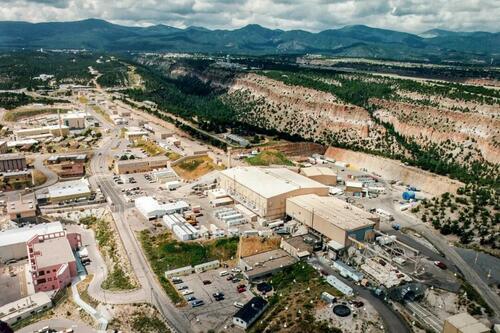
The plan found that because there isn’t enough housing, many people who do essential work in the community can’t live in the community.
The median sold price of homes in Los Alamos was $599,583 in September, representing a 6.3 percent increase from last year, according to a Rocket Homes report. In the same month, there were 61 homes listed for sale.
According to the housing plan, rental costs have more than tripled. Real estate website Zillow lists 33 current rentals available and a 3 bed, 1 bath house is listed for about $3,000 per month.
The lab employed 11,743 workers in 2018 and 15,707 workers in 2022, and it is hiring hundreds more this year and next before slowing down.
Meanwhile, in the same four-year timeframe, the county population only grew by 400 people because of housing constraints.
“This reflects the high percentage of commuters into the county, a limited supply of available housing, and the potential displacement of families with less financial resources by those with more,” the plan noted.
The plan projects that the county will require 1,300 new homes between 2024 and 2029 to preserve the status quo, and 2,400 new homes to meet future housing demand.
Tax Revenue
The fiscal year 2022 budget for LANL included nearly $2 billion in salaries for employees and $155 million in tax revenues for the county.
The lab was responsible for creating 24,169 jobs and contributing $3.12 billion to businesses in New Mexico.
Matteson said that LANL accounts for about 85 percent of the Los Alamos County’s gross property tax revenues.
“People come here because of the quality of life and amenities and things like that. The county feels it’s our job is to maintain those, increase where we can, and provide those services so people still want to live here,” Matteson said.
In September 2022, LANL announced its master development plan for the next 30 years.
The plan includes an upgraded facility powered by 100 percent renewable energy from solar and wind. The goal is to have zero carbon emissions by 2040.
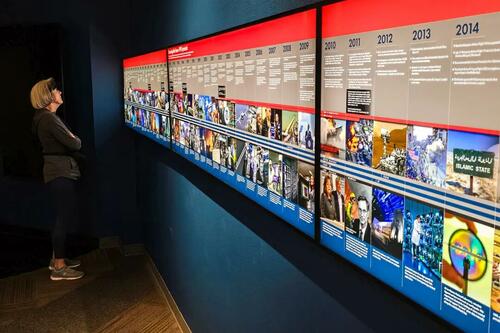
Atomic Legacy
LANL has come a long way since the top-secret Manhattan Project at Los Alamos that made the first atomic bombs used at the end of World War II.
On Aug. 6, 1945, the United States dropped a uranium bomb called “Little Boy” on Hiroshima, Japan. Around 140,000 people died in the explosion, which had the force of 15 kilotons of TNT.
On Aug. 9, 1945, the second 21-kiloton atomic bomb, dubbed “Fat Man,” was dropped on Nagasaki, Japan. It killed 74,000 people.
Los Alamos National Laboratory, built in 1943, played a leading role in the development and production of the U.S. nuclear arsenal during the Cold War.
The $39 billion facility is located about 35 miles from Santa Fe. It covers nearly 40 square miles of DOE property, nearly 900 buildings, and 13 nuclear facilities.
From 1952 to 1989, plutonium production for U.S. nuclear weapons took place at the Rocky Flats plant near Denver.
When Rocky Flats closed, PF-4 at Los Alamos became the only plutonium facility in the country. The National Nuclear Safety Administration (NNSA) monitors and oversees the recycling of plutonium from old pits to make new ones by LANL.

“Today, the Laboratory is laying the groundwork for manufacturing new pits that are bound for a weapon already in the stockpile, the W87-1 nuclear warhead,” according to LANL.
“Los Alamos National Laboratory remains the only place in the country where pits can be made. This critical mission endures as the driving force for national security through deterrence.”
LANL declined a tour request by The Epoch Times.
Building a Better Bomb
The 2022 Nuclear Posture Review of the U.S. Department of Defense identified improving America’s nuclear deterrent as a top priority in the face of emerging global threats and challenges.
“That modernization effort, which is being carried out over the next two decades, includes initiatives to modernize all three legs of the nuclear triad,” according to a Defense Department statement.
The new intercontinental ballistic missile (ICBM) system, Sentinel, will replace the old Minuteman III, which entered service in 1970 and will continue to operate until the mid-2030s.
The Columbia class ICBM submarine will replace the Ohio class submarines, and the B-21 Raider will replace the B-2A Spirit bomber.
The program also calls for upgrading nuclear warheads at LANL, which the DOE controls. The research and production capabilities of the lab are central to that modernization effort.
A law passed in 2018 authorized the lab’s plutonium production facility to make 30 plutonium warhead cores, or “pits,” each year by 2026. They will be used to replace the cores in the aging nuclear stockpile.
The nuclear weapons to receive the plutonium pits made at LANL include the W87-1 warhead for the next-generation Sentinel ICBM, the submarine-fired W93 bomb, and the W76, W78, and W88 warheads.
As reported by the Federation of American Scientists, there are 12,121 known nuclear warheads in the world in 2024.
There were 5,580 in the Russian Federation, 5,044 in the United States, 500 in China, 290 in France, 225 in the United Kingdom, 172 in India, 170 in Pakistan, 90 in Israel, and 50 in North Korea.
Read the rest here…
Tyler Durden
Sun, 10/06/2024 – 23:20
On The Jobs Report And Recession
On The Jobs Report And Recession
Submitted by Eric Hickman of Lantern Capital
The strong jobs report today (+254k) caused the dam to break on what I’ve been writing about for weeks with Treasury yields. The 2-year yield is higher by 22 basis points today. With the 2-year now at 3.93%, the bond market is priced for the Fed to cut rates to 3.25% by March of 2026. This would be a 25-basis point cut at 7.5 of the 12 meetings in between now and then. This seems like fair pricing for the conditions given the Fed’s desire to slowly get rates back to neutral.
But I’ve never seen a big pop like this be limited to just one day. I expect yields to continue rising for a while (particularly at the front-end of the yield curve) until negative economic data reasserts itself. The narrative from Austan Goolsbee, president of the Chicago Fed, and Jerome Powell is that the Fed is going to cut rates back to neutral (somewhere around 3%) with or without economic weakness. But Fed hawks are going to quickly worry about inflation after today and try to un-do the favorable financial conditions (low Treasury yields). For instance, Larry Summers said today that cutting 50 basis-points was a mistake. It wasn’t given the regularity of the business cycle, but he is a good barometer for the hawkish side of the Fed. I expect for some member of the FOMC to say a version of “don’t count on us cutting back to neutral.” If this is said, the 2-year will become un-moored. The jobs number today represents a narrative change, and it is a process to work through before rates fall again in this Treasury bull market.
But today’s economic data doesn’t change my expectation of a recession one bit; it just suggests it is further away until more negative economic data comes along. The preconditions are set and make economic sense. The inverted yield curve, the unemployment rate rising, and Leading Economic Index have all signaled a recession is coming. Historically, if two of these signal, a recession occurs. In this cycle, all three have signaled. See this image for further detail. Soft-landings have one or none of these conditions and are pretty evident in the charts below.
The arguments against this are that a recession hasn’t come yet, the Fed is going to lower rates before one comes, and that there are no economic imbalances to correct. Responding to the first, a recession has likely been delayed because of large fiscal deficits. The U.S. deficit to GDP in 2023 was 6.3%. The European Union, that began to cut rates the earliest of the G-7 in June, had a much-lower deficit to GDP of 3.6% in 2023. The UK, that began to cut rates in August, had a deficit of 4.4% of GDP in 2023. This correlation is too simplistic, but the point is that deficit spending buys temporary GDP growth and the U.S. has spent the most among the G-7, likely delaying the business cycle.
Second, the Fed is not going to be able to cut blindly down to neutral (around 3%). Inflation is a concern every step of the way and the reason why the Fed can never get ahead of the business cycle. Today is a good example with Larry Summers’ comments. The Fed needs to see escalating economic weakness as they cut to make them feel comfortable about inflation. I wrote more about this here.
In response to the third, risk-markets (i.e., the stock market) are the imbalance. The S&P 500 has returned 16.9% annualized (total return, dividends re-invested) since the Great Financial Crisis low on March 6th, 2009. It isn’t unusual for the stock market to go through 9-18 year periods with high returns like this, but it has been 15.5 years so far and with the labor market deteriorating, I think a recession is going to start a long period of mean reversion. See chart here.
Today’s jobs number fits into the volatility of a slowly deteriorating labor market and there are plenty of examples of big jobs numbers before recessions. Looking at initially reported data (not revised), non-farm payrolls were +372k in February 1990, six-months before that recession began. Payrolls were +268k in January 2001, two months before that recession began. And payrolls were +166k in October of 2007, two months before the Great Recession began. See chart below.
It is hard to find someone that doesn’t think this cycle will result in a soft-landing, but the time-tested signals are very clear about the opposite and the incentives to be optimistic among nearly everyone build-up the soft-landing theme into a bigger thing than it is. In a telling part of Jerome Powell’s interview with the President of the NABE (National Association of Business Economics), Ellen Zentner on Monday, Jerome Powell wouldn’t acknowledge a soft-landing,
ZENTNER: Do you think that the 50 basis points you delivered in September. That cut, you described as a strong start. Did that cut give you more confidence in a soft landing?
POWELL: [4-second pause] I would put it this way. It is a reflection of our confidence that inflation is moving sustainably down. Or, our growing confidence that it is moving sustainably down to 2%. You know, as I mentioned, our design overall is to achieve disinflation down to 2% without the kind of painful increase in unemployment that is often associated with disinflation processes. That’s been our goal all along. We’ve made progress towards it. We haven’t completed that task. I think you’ll see us using our tools in a way that shows our commitment to achieving that. I don’t want to make a judgement about its likelihood, I just want you to know that we are committed to using our tools to do everything we can to achieve that outcome.
ZENTNER : Well you know economists everyday are asked for a probability of a soft-landing. I try very artfully to avoid it, but I just have high hopes.
Think of how easy it would’ve been for him to say “yes” if he felt that way. Ellen Zentner’s response is a perfect encapsulation of how business economists feel, they try to be optimistic despite what they may see. Not only do I see a recession coming, but I’ve yet to see a credible reason why it wouldn’t. Today’s jobs number has nothing to do with it.
Tyler Durden
Sun, 10/06/2024 – 17:30
As Unrest In Communist China Grows, So Does Its Aggression On The World Stage
As Unrest In Communist China Grows, So Does Its Aggression On The World Stage
Authored by James Gorrie via The Epoch Times,
At this point, China’s declining economic situation is well documented. The damage is too large to cover up with propaganda, and the Chinese people know it. Even the Chinese Communist Party’s (CCP’s) 75th anniversary was austere. Negative economic factors have been building for years.
China was already having problems in 2018 and 2019 with the Trump administration’s imposition of steep tariffs on Chinese goods. But the COVID-19 pandemic and the CCP’s extreme “zero-COVID” three-year lockdown period made China’s economic downturn much worse.
China Is Being Tested
As we approach the last quarter of 2024, the CCP is being tested by unprecedented domestic economic conditions. As a result, civil unrest is 18 percent higher than last year. The slowdown has many facets, of course. We’ll name just a few in this space.
One big factor is the real estate sector, which is about 30 percent of GDP. It continues to crater, and at the time of this writing, there is no recovery in sight. Home prices and sales continue to decline. What’s more, Chinese consumers are buying less, with consumer spending making up just 38 percent of GDP. By contrast, that figure is 60–70 percent in developed countries.
Sloth and Disillusion
Not unexpectedly, unemployment among China’s youth (ages 16–24) had been at least 21 percent and likely higher when the CCP stopped publishing unemployment figures in June 2023. Then, in December of that year, the CCP released new statistics from a new method of measuring youth unemployment, which did not include students. That new approach dropped that figure down to 14.9 percent, but that’s still almost three times higher than China’s national rate of 5.1 percent.
High jobless rates for young people hinder future growth potential and have added to the “lie flat” trend amongst many in China’s new generation, who have little hope of or ambition to obtain the lifestyle that their parents enjoyed.
Sloth and disillusion are hardly the stuff that strong economies are made of. The risks and dangers of disaffected youth movements are not unknown in China. The ghost of Tianuare still haunts Chinese authorities, even though the surveillance and control that the CCP has over its people is light ahead of the Tiananmen Square era of 1989.
Embedded Political and Industrial Policies
Still, there are embedded economic realities that can’t easily be changed. Party doctrine dictates that China’s top economic advantage is found in its low levels of domestic consumption and high savings rate. These two factors mean domestic capital flows directly into the state-controlled banking system, which it can then allocate to specific industries. This gives the Party tremendous control over industrial policy and private capital.
For instance, China’s economic and development structures are geared toward high levels of industrial output. That may seem fine, but because China’s political organization and industrial arrangements within the Party are focused on large production capacity and not innovation or differentiation, the outcomes are massive overproduction that is often well beyond global demand and unprofitable factories.
Constant oversupplies, from electric vehicle batteries to electronics, result in Chinese manufacturers dumping massive amounts of cheap products into foreign markets, triggering trade friction such as tariffs and other retaliation, which also make conditions worse in China.
In short, China’s distorted industrial policies tied to a graft-loyalty political system have made it incapable of changing without disrupting the CCP structure and the loyalties that come with it.
No Stopping the Downward Spiral
For these reasons and others, over the past several years, China has found itself in a downward spiral of deflation, falling domestic consumption, and declining confidence in the CCP. What’s more, there are few real options that won’t threaten the CCP’s grip over the country. It must be made clear, however, that with its surveillance capabilities, the Party can handle a loss of confidence in the eyes of the people, but it can’t survive a loss of power. The two are not the same.
What the CCP will do is continue to support some critical areas of the economy, such as artificial intelligence, robotics, and military enhancements, while letting other sectors flail without little or no bailouts. Some sectors will eventually return, but not in the near future. This is clear to many within and outside of China, as billions of dollars in investment and capital continue to exit China.
Wolf Warrior Diplomacy Is Alive and Well
This brings us to China’s so-called wolf warrior diplomacy approach toward other nations, which it adopted in 2019 on the cusp of the COVID-19 outbreak and global criticism of Beijing’s disastrous handling of the pandemic. China was already under economic duress due to the rising trade war with the United States. Some observers attribute this approach to personal ambition among China’s diplomatic personnel and/or an attempt to improve the perceived investment environment in China.
Neither makes any sense when it’s understood that Xi Jinping is not allowing diplomats to make their own rules and policies, and pre-wolf warrior investment levels were high. Why would the CCP authorities imagine that increasing aggression on the global stage would make more countries want to invest there? They don’t.
A more realistic rationale for China’s rising aggression on the world stage is that Beijing feels the need to control the narrative at home and intimidate the rest of the world. The spillover between a declining economy and rising unrest is clear. At home, the CCP needs to blame the West and other foreigners for its blatant economic failures not only for exculpatory purposes but also to whip up nationalism and justify further aggressions as economic conditions continue to deteriorate.
Some observers have concluded that Beijing’s days of wolf warrior diplomacy are now over. Current events, however, defy such a conclusion. These include the Chinese regime’s provocative incursions with military planes and boats into or near territorial waters or air space of the United States, Taiwan, and the Philippines, border battles with India, as well as a desire to expand control of the South China Sea. On the global stage, as the return to bullets over diplomacy rises, Beijing sees an opportunity to influence and/or intimidate other nations.
Tyler Durden
Sat, 10/05/2024 – 23:20
Concerns Raised About Toxic Exposure In Aftermath Of Helene Floodwaters
Concerns Raised About Toxic Exposure In Aftermath Of Helene Floodwaters
Authored by Edward Carver via Common Dreams,
Local officials, academic researchers, and volunteer responders have raised concerns about chemical and biological contamination brought by the floodwaters of Hurricane Helene in the southeastern U.S. last week, which potentially threaten the safety not only of drinking water but also the quality of soil—leading experts to call for tighter regulations on stored pollutants.
Helene struck Florida as a Category 4 hurricane on September 26 and swept through a number of states in the days that followed. Most of the damage came from extreme rainfall that triggered flooding. The storm killed at least 232 people. The biological and chemical threats posed by floodwaters are typically manifold, often containing, for example, e. coli from overflowing sewage systems.
While it’s not yet clear what bacteria or chemicals Helene’s floodwaters may have contained, the storm passed through hundreds of industrial sites with toxic pollutants, including paper mills, fertilizer factories, oil and gas storage facilities, and even a retired nuclear plant, according to three researchers at Rice University, writing in The Conversation this week.
The researchers called for tighter regulations on the storage and release of chemical pollutants. “Hazardous releases remain largely invisible due to limited disclosure requirements and scant public information,” they wrote. “Even emergency responders often don’t know exactly which hazardous chemicals they are facing in emergency situations.”
“We believe this limited public information on rising chemical threats from our changing climate should be front-page news every hurricane season,” they added. “Communities should be aware of the risks of hosting vulnerable industrial infrastructure, particularly as rising global temperatures increase the risk of extreme downpours and powerful hurricanes.”
The devastation of infrastructure and the lack of drinking water in cities such Asheville, North Carolina, has rightly received national media attention following the storm. In North Carolina alone, more than 700,000 households lost power, and 170,000 still didn’t have it as of Thursday.
Yet the National Weather Service warns that while floodwaters can create clear-cut devastation, “what you can’t see can be just as dangerous.” Helene also brought with it public health concerns that are less obvious, including to other, non-public sources of drinking water.
Helene’s floodwaters overran many wells, rendering them unsafe to drink, at least until treatment and testing can be done. North Carolina’s Department of Health and Human Services advised residents not to use contaminated well water earlier this week.
One problem following Helene is that most studies of flooding’s impact on drinking water have been done in coastal areas, and it’s not clear how they apply to the mountainous areas of North Carolina that took the worst hit from the storm.
“We don’t have a lot of knowledge about mountain flooding, from a hydrology standpoint,” Kelsey Pieper, a professor in environmental engineering at Northeastern University, toldInside Climate News.
“Water velocities tend to be higher in mountain floodings because it’s getting funneled into the valley, where the water is accumulating. In a coastal area, you’re going to see more water spreading out,” she said. “The flooding mechanisms are different, and we know very little.”
Wells tested in eastern North Carolina after Hurricane Florence in 2018 showed some detections of e. coli or total fecal coliform, which were partly attributed to industrialized hog farms in the area, Inside Climate News reported.
Crops are often rendered unsafe after flooding due to biological or chemical contamination, according to Food Safety Alliance. Natural bodies of water are also often unsafe to swim in following floods. Virginia Department of Health and other agencies warned people to avoid them after Helene.
The period after a tropical storm brings increased risk of both biological contaminants, such as bacteria and viruses, and chemical contaminants, such as heavy metals and pesticides, according to the Duke University Superfund Research Center.
Following Helene, a grassroots volunteer cleanup effort has sprung up in western North Carolina, but it brings risks for the volunteers because of the potential contamination.
Another devastating scene due to Hurricane Helene’s impact in several states. We are in the historic downtown area of Marshall, N.C. where the clean up process has started. We’ve seen people with PPE and hazmat suits as we’ve been hearing the mud in this area is hazardous. pic.twitter.com/K52uZceDE4
— Cristina Corujo (@cristina_corujo) October 4, 2024
“We were supposed to get a big shipment of gloves, coveralls, masks, respirators, but we aren’t,” Rachel Bennett, a coordinating volunteer in the town of Marshall, which sits along the banks of the French Broad River, told the Citizen Times, an Asheville newspaper. “So, we’re hoping to get more. Those are the big things because we’re in cleanup right now. We need thick things.”
“Right now, it’s boots, and it’s hard to get people to put on gloves, because when you’re in this, you’re like, ‘I’m already exposed,'” she added.
A Marshall resident conducted a soil test this week but the results haven’t come back yet, the newspaper reported. “All of these rivers should be treated as hazmat sites,” Buncombe County spokesperson Stacey Wood said at a briefing Friday, according to a local journalist. Buncombe County encompasses Asheville and Marshall is just outside it.
The Rice University researchers called for better preparation for future storms in the form of stronger regulation. They’ve developed a map showing the U.S. areas that are most vulnerable to chemical pollution brought on by floodwaters. One hotspot is the area of Texas and Louisiana full of petrochemical industry sites.
Tyler Durden
Sat, 10/05/2024 – 22:10
What Would World War III Really Look Like? It’s Already Starting…
What Would World War III Really Look Like? It’s Already Starting…
Authored by Brandon Smith via Alt-Market.us,
One of the most common assumptions I come across in the survival-sphere is the idea that the next world war would automatically necessitate global nuclear conflict and a Mad Max-like outcome. In other words, a lot of people assume we aren’t in a world war until the nukes start flying and the survivors are left fighting in soda can armor over an irradiated desert. This is a dangerous misunderstanding for a lot of reasons.
What people are overlooking is the fact that we are ALREADY in the middle of WWIII. They don’t realize it because they’ve based their entire concept of world war on Hollywood fantasy.
There are many ways in which wars are fought. In our current situation WWIII is being waged through proxies like Ukraine and Israel (and maybe Taiwan in the near future). The war is also being fought on the global economic stage using sanctions, inflation and the dumping of the US dollar as the world reserve. To be sure, these situations can easily escalate into something bigger and that is exactly what I suspect they will do. However, planetary nuclear war is the least likely scenario.
Survival and preparedness communities have a tendency to hyper-focus on the obviously Apocalyptic. We talk a lot about EMP strikes and split-second grid down calamities. We talk about solar flares, overnight economic crashes and nuclear holocaust. I think survivalists do this because it acts as a mental exercise – A way to better clarify what the best preparedness solutions are in the majority of cases, including the worst cases.
But as I’ve said for many years, collapse is a process, not an event.
These things happen slowly, and then all at once. If you went back in time ten years ago and warned people that in 2024 the US would be in the middle of a stagflationary crisis with a 30%-50% average price increase on all necessities, they would probably dismiss you as a doom-monger. Well, guess what, that’s exactly what a handful of alternative economists (myself included) were doing well over a decade ago, and we were dismissed over and over again – Welcome to our world.
The reason people refused to believe us is because the danger was not immediately obvious. The economic threat was not hitting them in their wallet yet. Stock markets seemed to be doing fine. The jobs market was still functioning somewhat normally. They could only view economic crisis through the lens of a total collapse. The idea that it would happen incrementally never crossed their minds.
Even today there are still people who argue that everything is fine. The stock market is “fine.” The labor market is “healthy.” If you suggest all is not well, you’re a “chicken little.” This is the incredible danger of having a Hollywood fantasy idea of collapse. We may never get to 100% systemic implosion; but even a 50% collapse is still a survival situation.
The same dynamic goes for WWIII. We must not overlook the dangers right in front of us simply because intercontinental ballistic nuclear missiles aren’t crisscrossing the sky.
Consider the proxy battleground case for a moment.
In October of 2023 I published an article titled ‘It’s A Trap! The Wave Of Repercussions As The Middle East Fights “The Last War.”’ In it I stated:
“Israel is going to pound Gaza into gravel, there’s no doubt about that. A ground invasion will meet far more resistance than the Israelis seem to expect, but Israel controls the air and Gaza is a fixed target with limited territory. The problem for them is not the Palestinians, but the multiple war fronts that will open up if they do what I think they are about to do (attempted sanitization).
Lebanon, Iran and Syria will all immediately engage and Israel will not be able to fight them all – Hell, the Israelis got their asses handed to them by Lebanon alone in 2006. This will result in inevitable demands for US/EU intervention.”
I also warned on the potential motives behind escalation in the Middle East:
“The timing of the conflict in Israel is incredibly beneficial to globalists, and this might explain Israel’s bizarre intel failure [October 7th]. Just as US and British leaders had prior knowledge of a potential Japanese attack on Pearl Harbor in 1941 but warned no one because they WANTED to compel Americans to fight in WWII, the Palestinian incursion serves a similar purpose.”
I my article ‘Iran vs Israel: What Happens Next Now That Shots Have Been Fired?’ published in April, I predicted:
“A ground war between Iran and Israel is inevitable if the tit-for-tat continues, and much of it will be fought (at least in the beginning) in Lebanon and perhaps Syria. Iran has a mutual defense pact with both countries and Lebanon is generally a proxy for Iranian defense policy.
Iran will have active troops or proxy forces in all of these regions, not to mention the Houthis in Yemen striking ships in the Red Sea. There are questions in terms of how Iraq will respond to this situation, but there’s not a lot of love between the current government and Israel or the US.”
Not surprisingly there was a contingent of people that argued these things would “never happen” and talk of war between Iran and Israel was “doom mongering.” Those people were wrong (yet again), and I was right. Iran and Israel have now essentially declared war on each other and are exchanging missile barrages as I write this. The ground war will begin in Lebanon and expand from there.
Just as in Ukraine, the looming danger is that war between Israel and Iran will draw in larger military powers like the US and Russia.
People dismiss this outcome because their modern conception of global war needs to change; this world war will not be fought exactly like those in the past.
This time the weapons of mass destruction will be financial and resource driven instead of nuclear. If Iran moves to blockade the Strait of Hormuz (which I believe is imminent), Americans can be harmed financially through energy shortages and gas price spikes even without our soldiers deployed to fight.
There’s also the question of our wide open borders and how many potential terrorists slipped into the US during the Biden Administration’s illegal immigration bonanza. How many attacks (or false flag attacks) are being organized right now?
The regional conflicts could spread and go on for a decade or longer. It all adds up to a world war, but it may never be officially declared a world war. Perhaps there will be a limited nuclear event somewhere; maybe a false flag or a limited strike. But a nuclear war is not necessary to create the kind of chaos the globalists are looking for.
People also need to understand that the powers-that-be also have a lot to risk should a war devolve into nuclear exchange. If it was really that easy for them to launch warheads, wipe out the majority of the human population and then establish a global dynasty, they would have done it a long time ago.
Global war on such a scale is inherently unpredictable. The elites have spent trillions of dollars and the better part of the last century constructing the most complex surveillance and control grid in history. It would be foolish to turn it all to ash in the blink of an eye and I highly doubt that’s the plan. They would be putting themselves and their legacy at risk of being erased forever.
Does this mean I will be ignoring the potential for a nuclear event? No. I will always keep it in mind and have preps ready just in case. A single nuke set off anywhere west of your home could result in radioactive fallout that would take around three to four weeks to dissipate. That said, the danger of these sceanrios might be overstated.
Here’s an interesting fact to ponder: The US government has tested at least 1050 explosive nuclear devices over the decades. Around 216 of those were atmospheric tests that resulted in massive fallout across the country. Some people in close proximity got sick over many years from these tests, but they didn’t result in an overnight mass death event. Perhaps, at a moderate distance, these weapons are not as dangerous as we’re led to believe?
The greater effect of nuclear weapons comes not just from the resulting damage to national infrastructure, but also mass psychological disruption. The economic system would take an immediate dive from even one strike, and it could be anywhere in the world. A single nuke in Ukraine would send shockwaves through already unstable markets. The supply chain and food supply could be quickly disrupted.
If the globalists wanted to accelerate a worldwide collapse, they wouldn’t need a nuclear war, just one well placed device.
The biggest danger from WWIII is not nuclear exchange, but the disturbing changes societies go through when conflict inspires mass fear. Totalitarianism is much easier to institute during such a war. Freedom of speech is often suppressed and criticism of the government is often criminalized. People who rebel against this are accused of “working with the enemy.” Military conscription is usually enforced and young people are sent off to die overseas over a conflagration that makes little sense.
The economy nose dives and the supply chain tightens. Price controls and rationing are initiated. Black markets flourish but those who participate are aggressively targeted by the government. In the case of the US, armed revolution in many states is a certainty.
Public planning should focus far more on these eventualities and less on Hollywood images of Apocalypse.
* * *
One survival food company, Prepper All-Naturals, has proactively dropped prices to allow Americans to stock up ahead of projected hikes in beef prices. Their 25-year shelf life steaks currently come at a 25% discount with promo code “invest25”.
Tyler Durden
Sat, 10/05/2024 – 17:30

